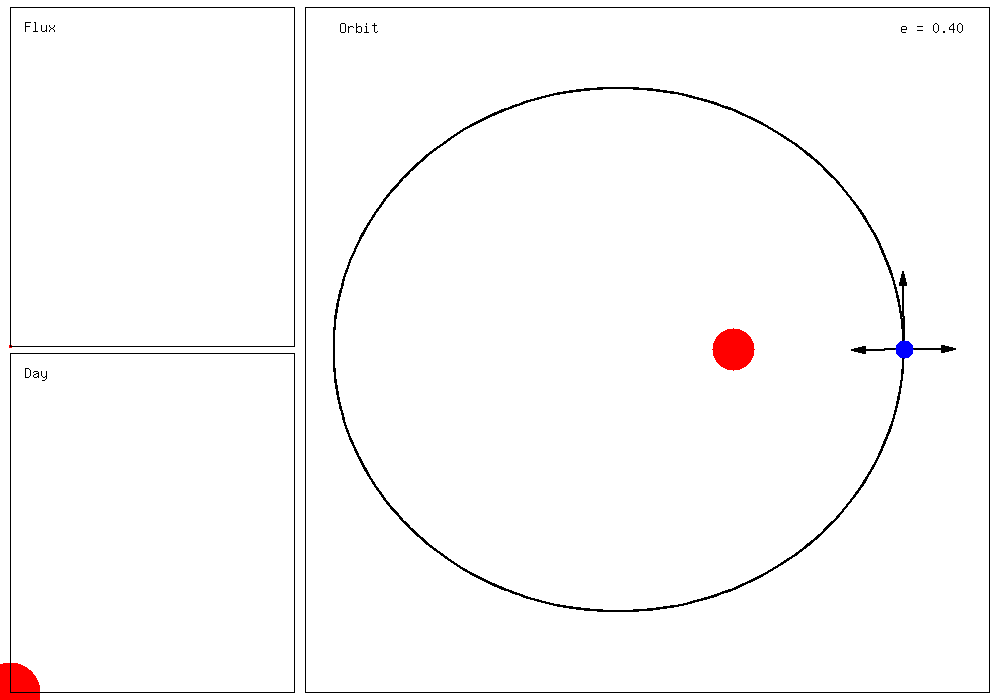3:2 spin-orbit resonance
This movie shows a blue planet orbiting a red star in a special way that is called 'spin-orbit resonance', where the spin period of the planet is connected to the orbital period by a simple ratio. In this example, the planet spins exactly three times on its axis for every two orbits of the star. The right-hand side of the movie shows the orbit, while the left-hand side shows the flux received and what the sun looks like from the point of view of an observer on the equator of the planet at the location of the large arrow. A 3:2 spin-orbit resonance is exactly the configuration of the planet Mercury. For comparison, the Earth spins ~366 times per orbit (not ~365, think about it!), and is not in a resonant configuration. Tidal forces exerted by the Sun on Mercury are thought to be responsible for driving it into this 3:2 spin-orbit resonance, much in the same way that tidal forces from Earth have driven the Moon into a 1:1 spin-orbit resonance, which is why you only ever see one face of the moon.

It is thought that some eccentricity is required to drive planets into resonances such as 3:2, and in the previous example the orbit of the planet was circular. In this movie, the orbit has changed to be mildly eccentric, with e = 0.15. The large arrow denotes the 'up' direction from the point of view of our observer: the sun is directly overhead when this arrow is pointing towards the star and this is then mid-day. The two smaller arrows indicate the horizon and when one of these is pointing towards the star; it would be either sunrise or sunset for our observer. Note that the passage of the sun slows down in the sky around mid-day, which is a bit strange. A quick look at the previous movies, combined with a small amount of thinking, will convince you that one 'day' lasts two 'years' (orbital periods) for our observer, and that the system is exactly periodic over two orbital periods. Is this interesting? Maybe a bit.

Things get more interesting when we consider higher eccentricities for the same 3:2 system, such as in this movie where e = 0.25. The eccentricity means two things for our observer: First, that the distance to the sun changed appreciably over one orbit, hence the sun in the sky appears larger or smaller depending on the orbital phase. Second, the angular velocity changes significantly over the orbit, with it being fastest when the planet is closest to the sun and vice versa. Note that the sun actually moves backwards in the sky here around mid-day! How the sun transitions across the sky for our observer depends on a competition between the (constant) angular-spin rate of the planet and the (not constant) angular-orbit rate. For these higher eccentricities the increased orbital angular speed around the point of orbital closest approach means that actually the sun moves backwards in the sky for a short time, prolonging the mid-day for our observer.

Things get stranger if we consider our observer to be at a different longitude on the surface of the planet, such as in this movie. In this case the 'day' is actually broken up into three distinct phases of daylight and the sun will rise thrice and set thrice throughout the 'day'. For this longitude, this manifests as one longer period of daylight when the planet is furthest from the sun and then two short bursts of light with the sun closer, but low in the sky. Note that this also means that the total received flux, and the rate at which this flux is deposited, varies as a function of planetary longitude, as well as the standard latitudinal dependence. This is different to Earth, where all longitudes are equivalent in terms of the flux they receive over a year.

As the eccentricity becomes more extreme so does the weird behaviour. When e = 0.4, as in this example, the observer receives more instantaneous flux from the short sunset-sunrise times than they do during the longer day, so the best tanning time occurs when the sun is low in the sky, but compensatingly close. There is a critical value of the eccentricity at which the retrograde motion of the sun and the corresponding strange behaviour becomes possible. It turns out that this can be obtained as the solution to a cubic equation, and the critical eccentricity is ~0.193. The eccentricity of Mercury is ~0.205 so the retrograde motion of the Sun would only be visible for a short time, and there are only very specific longitudes on the surface of Mercury when you would see a triple sunrise phenomenon over the course of one 'day', which on Mercury lasts for ~176 Earth days.

This may all seem like an academic exercise, but many planets have been discovered around low-mass stars, and the habitable zone for these stars is much closer to the star compared to that around our Sun. The relative importance of tidal forces increases more quickly than the gravitational force as you go near a star, it has an r-cubed dependence rather than r-squared, so planets in the habitable zone around low-mass stars are expected to be in spin-orbit coupled configurations. These could be 1:1, like the Moon-Earth resonance, but other situations such as 3:2, 2:1, 5:2, ... are also possible. So there could be funny aliens out there in the cosmos who have a very different conception of what a day means compared to that which we have on earth. These aliens would also have to get used to the fact that the total received flux in one 'day' varies as a function of longitude.